5 E-learning Samples Developed in Lectora Inspire

When e-learning developers want to convert text-heavy courses to the e-learning format, they look to Lectora Inspire. Lectora enables you to create simple, interactive elements even if you have no knowledge of Flash. This rapid authoring tool offers many features that make it the favorite of courseware developers.
- Develops responsive design courses that can be accessed from multiple mobile devices
- Provides easy-to-use templates which save valuable development time
- Makes translations simple
- Customizes quizzes
- Designs graphics, captures screens, and audio narration
Lectora offers a user-friendly interface and addresses many course development needs. Let’s look at a few needs it serves.
Conversion of text-heavy content into engaging e-learning:
The tool allows you to convert text-heavy content such as compliance material or product manuals into engaging e-learning. This is possible because the tool allows you to fit as much text as you want on to the screen, without a vertical scroll. You can even customize the interface based on your requirement.
Responsive design:
Even if you design courses for the desktop view, the tool will automatically rescale the design for mobile devices. The view can be customized based on the device.
Assessment and quizzing options:
With this tool, you can create assessment scenarios and Flash-based mini games. Built-in quiz templates make the creation of customized quizzes easy. It offers LMS compliant options as well.
Interactions:
The in-built interactivities can be customized according to your requirements. Unlike other authoring tools, you need not check for add-ons to incorporate interactivities in your course.
Multilingual online content:
This online course development tool allows for the conversion of courses into Rich Text Format (RTF) files for translation. The files, once translated can be imported back into the tool to create the translated course. A multilingual interface can be created for the course which allows the learner access the course in the language of his choice.
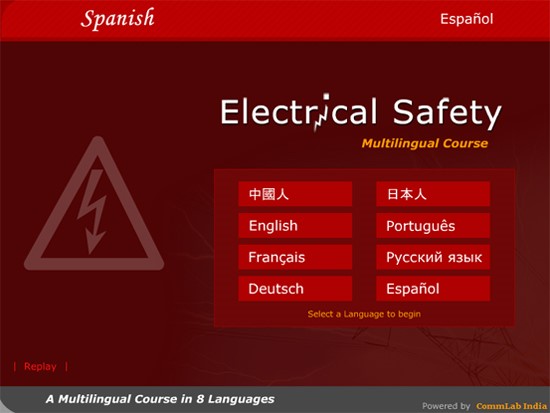
Mobile learning apps:
The rapid authoring tool produces editable HTML5 output which can be tweaked to develop mobile learning apps using third party applications such as PhoneGap.
Now let us look at five samples of e-learning courses developed by CommLab India using this versatile development tool.
1. Online course for the sales force of a healthcare equipment manufacturer
The healthcare manufacturer wanted to educate its sales force on the maternity process and pre and post-natal care of the mother and child. The company felt this knowledge would help sales people convince prospective buyers to purchase their equipment while educating them about its benefits.
The course was completely fact-based and had details of the childbirth process. Lectora was the tool of choice because:
- The course dealt with complex and conceptual subject matter
- Heavy text had to be converted to an engaging e-learning course
- The course had to be visually enhanced with silhouettes and vector images
- Animated infographics and interactivities had to be used to explain the subject
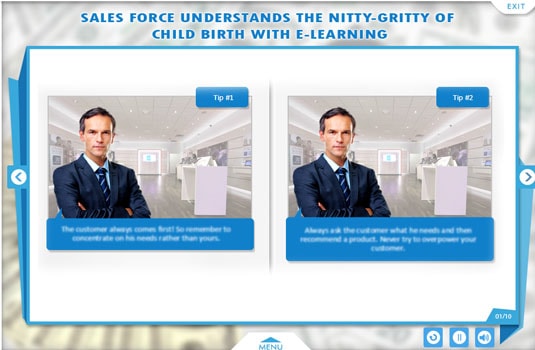
2. M-learning to reduce workplace injuries
A precision weighing and measurement instruments manufacturing company wanted to reduce the incidence of workplace injuries by educating their technicians about unsafe practices. Teaching every technician through classroom teaching would be time-consuming and require a lot of resources. To avoid this, the company wanted to train them through m-learning.
Lectora was the ideal authoring tool for this course because it enabled the development of dynamic mobile content. Content could be easily published to HTML5 that will help access the content on any mobile device. Other reasons were:
- Content had to be adjusted based on the size of the mobile screen
- Line drawings had to be used to depict content
- Audio and video files had to be embedded in the course
- Transformational visuals were used to help learners clearly understand the safety practices
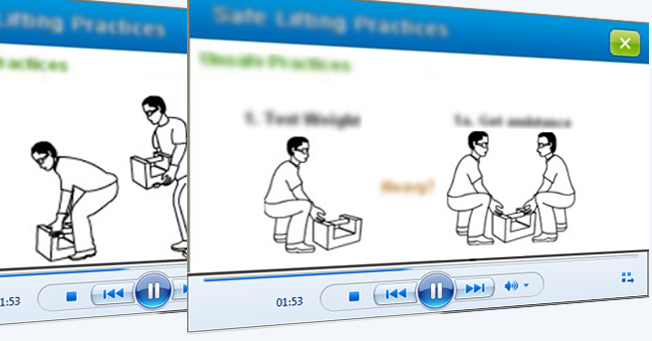
3. Converting a text-heavy document to an engaging e-learning course
A pharmacist’s guild wanted to develop an online course for its members to impart knowledge on the need for immunization services in pharmacies. The course had to be developed in 15 days from a 165 page MS Word document. Lectora was selected because the course could be created through a quick conversion of the Word document. The tool helped enhance the course through the:
- Use of rich visuals
- Addition of interactivities
- Use of customized assessments
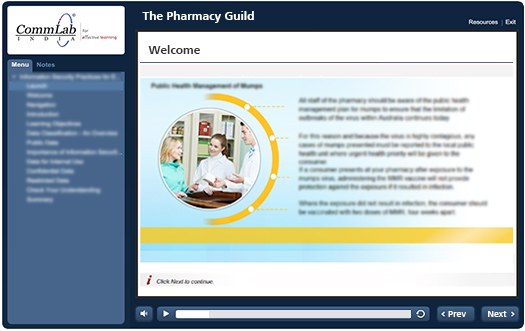
4. Teaching factual information
A medical equipment manufacturing company wanted to teach its employees the anatomy of the respiratory system through a graphically rich e-learning course. The course had to explain the pulmonary system and the complications associated with it. The course had to be learner-centric and visually rich.
Lectora was used because it is compatible with Flash and can be used to develop a visually rich course. The tool helped:
- Embed facts and procedures
- Support different image formats
- Integrate multimedia, assessments, and Flash animations with the courseware
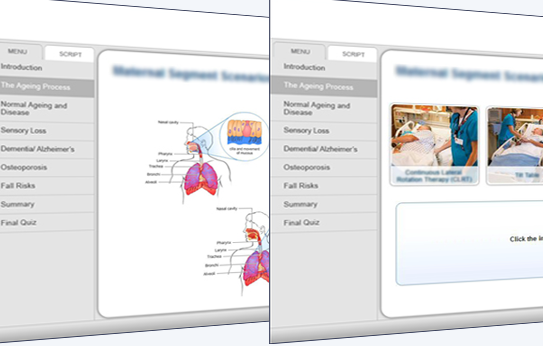
5. E-learning course on financial planning
A financial company wanted to create an e-learning course for its financial planners. The aim of the course was to help learners identify the key knowledge areas related to general insurance products. They wanted to launch the course on their own LMS.
Lectora was used to develop the course because it could:
- Present facts and concepts in an appealing way
- Create appealing visuals
- Use animations to create an interactive course
The multiple features of Lectora equip it to meet the demands of courses with varied training objectives. The tool is preferred when text-heavy courses have to be converted to e-learning or responsive design is required. It can save valuable development time when creating courses for m-learning.
There are many choices when selecting the right authoring tool for e-learning development, sometimes leaving e-learning developers confused. To solve the problem, download our e-book How to Select the Right Rapid Authoring Tool. Here you will find features of five widely used rapid authoring tools with a comparative analysis to help you make an informed choice.





